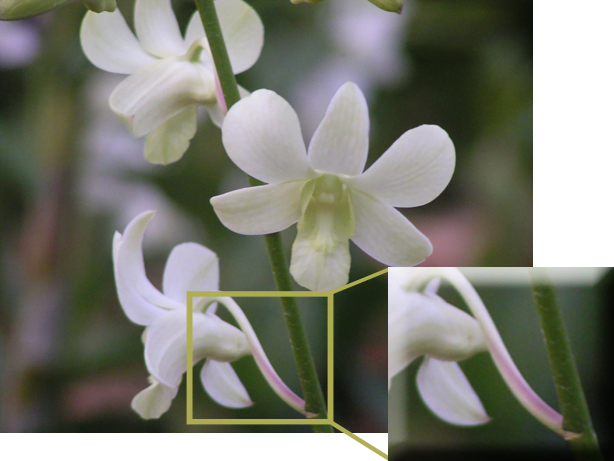Self-pollination can be done to produce a range of varying offspring. Usually, the offspring plant with the most desirable phenotypical characterisitics are selected for cloning (A.K.A. mass production). In reality, a batch of clones are not guaranteed to yield identical flowers. A slight degree of variance can still surface; and mutations (due to chemical/environment etc) amongst some of the plants are still possible.
To illustrate, the following are examples of the Dendrobium Shavin White and two variations:
The typical Dendrobium Shavin White flower is greenish-white when it blooms initially. The greenish colouration fades resulting in a more whitish colour, as the flower fully blossoms.
In variation 1, pink flushes are observed along the petals and sepals, with a strong pigmentation of pink along the centre of the lip.
In variation 2, the reddish-pink colouration can be observed spreading from within the column.
Cloning the above variations could produce batches of atypical looking Dendrobium Shavin Whites. However, if the variations arose from unstable mutations, there’s a higher chance that their clones may end up being typical rather than atypical based on our experience.
The Dendrobium Shavin White cut-flowers have been circulating in the market for almost three decades. The Dendrobium Shavin White’s sustainability over the years is attributed to its well-aligned blooms, lasting flowers and strong flower stalks; and also being frequent flowering and maturing quickly. Notwithstanding, favourable genes from its pedigree should be credited. The Dendrobium Shavin White is a cross between the Dendrobium Walter Oumae and Dendrobium Queen Florist. In particular, the Dendrobium Walter Oumae has favourable characteristics and is used extensively for crossing. (It is the parent of more than 50 registered orchid hybrids).
Notably, both parents of the Dendrobium Shavin White are prominently white in colour, so it’s peculiar to find pinkish or reddish colourations. Bearing that in mind, reddish colours could already be embedded within its recessive genes; and only by chance will they be revealed. The following picture and magnification shows the typical (greenish-white) Dendrobium Shavin White, but a slight tinge of pink can be observed along the pedicel (“branch” attaching the flower to the stem). Due to its ancestry or hidden recessive genes, the Dendrobium Shavin White have the mutative propensity to reveal the reddish colour. Through self-pollination, typically hidden characteristics are uncovered and amplified.



Hi,
I’ve got 4 orchid a young beauty a princess white(or a peach don’t really know) a burana jade and genting casino which I bought from your nursery
After pollination, how will the new variation of orchid form? Does
It bloom into another flower? Or does it grow into a new stem?
What do I do after pollinating? Just leave it there? What if the flower withers?
Thanks.
Hi Mane,
Upon successful pollination, the petals of the flower will wither off, and a seedpod will start to form. It will reach maturity in about two to three month’s time for these Dendrobiums. Upon maturity, the seedpod will be brown and firm. Seedpods are usually germinated in sterile lab conditions to reduce mortality rates and increase chances of germination. In three to six month’s time, the powdery seeds from the seedpod will germinate into seedlings (baby orchids). These seedlings will generally take another fifteen to eighteen months to produce their first flowers, small and short raceme.
The resultant form, colour and characteristics of the new hybrids are derived from both the parent plants. For some offsprings, the characteristics might be more dominant from one parent than the other, and if there are recessive characteristics embedded within the two parent plants but masked by dominant alleles can also resurface. Thus, occasionally characteristics that are not present in both parent plant can appear as well.
If you wish for your orchid to grow new stems, you can do it via vegetative propagation. you may refer to this article http://tohgarden.com/others/producing-keikis/. Offsprings produced via vegetative propagation will have flowers similar to the parent plant.
silverelf
I’ve recently purchased 5 dendrobiums from Trader Joes in Montrose, California, USA. The one with the most blossoms, buds and plants, has wrinkled leaves. Should I be concerned?
I recently purchased 5 dendrobiums. The one with the most plants, buds and flowers has wrinkled leaves and one leaf has a white powdery substance on it. Should I quarantine and spray with Neem Oil before introducing it to the rest of my collection of dendrobiums and phals?
Hi J. Bulbuk,
Its likely that the plants are dehydrated after import. The plants should regain turgidity after it gets hydrated.
Yes, its definitely better to quarantine and spray with Neem Oil before introducing to the rest of your collection.
The white powdery substance might also be fungicide that’s used for treatment prior to export.
silverelf
Thank you for your quick response to my e-mail. Have a lovely day.